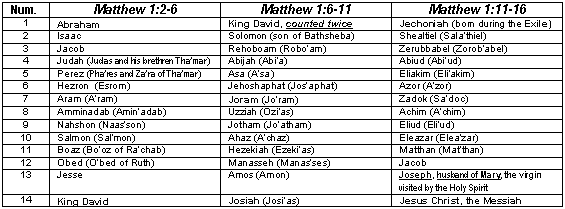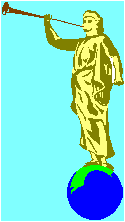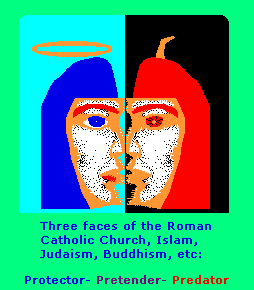Religion, Mythology, Metaphysics
(The Study of Threes)
http://threesology.org
| In The Beginning page 1 |
In The Beginning page 2 |
In The Beginning page 3 |
In The Beginning page 4 |
In The Beginning page 5 |
In The Beginning page 6 |
In The Beginning page 7 |
Since different readers may come to one of the pages in this series other than the first page, it is necessary that the following paragraph be placed on all of the pages:
In The Beginning... that is, after the development of biology and the semblance of culture after the early hominids and initial emergence of what we of today denote as modern man designated by Cro-Magnons. And yet, "the beginning" is not limited solely to western perspectives of early religious thought and later ideological correlations. And though we of today describe many of the early ideas as myth and legend, those in the past may well have viewed such ideas as being factual. Yet, the point to be made in the present series of "threes" examples is that there was and is a current of thought processing which regularly used patterns-of-three to organize information... or at least we of today use patterns-of-three even if peoples in the past had no particular affection for one or another numerological labeled pattern. And inasmuch as we of today use enumeration to list multiple examples from not only different cultures regarding the same subject, we also include examples from a diverse array of subjects because all of them represent a collective human cognition. Providing numerous examples-of-three does not in any way suggest there are no other patterns nor that it is the sole dominant pattern in every instance. Clearly, because there are multiple number patterns but that the overall list of number patterns is small, suggests human cognition is either limited in its processing ability due to a genetic design, and/or that there is an external factor that is or was dominant in creating such a limitation on human physiology and overall genetics. In addition, if it is due to an environmental factor and that factor(s) is deteriorating (or otherwise), then it is prudent for us to take stock of such a situation as a means of prediction and possibly control.
H.O.B. note: One must consider the possibility that the "Trinity" of some religion belief systems was due to the presence of three-based god or other religious ideas used by so-called pagan beliefs, since the Christian church of Rome and elsewhere adopted pagan beliefs into its own ideology in order to gather more followers under its control. Hence, it is not that other beliefs have adopted a "three" structure according to some Christian theology using the Trinity formula, but that these theologies took their lead for developing a Trinity after the "threes" ideas of others. To claim that others get their "threes" ideas based on the Christian Trinity is a salesmanship tactic to give oneself importance over others and thus sustain a presumed dominant position in religious thought.
3 "11" Generations of Jesus Christ: (In the first chapter of the New Testament in Matthew 1:17)
- These are fourteen of the generations from Abraham to King David and,
- Fourteen from King David's time to the exile and,
- Fourteen from the exile to Christ
The genealogy (Heb. yachas, Gr. genealogia) is listed as such: Genealogy of Jesus Christ is divided into three sets of fourteen generations each, probably to aid memorization.

--- Generations of Jesus Christ ---
The Islamic tradition (Koran 74.8) relates that God created a special angel Israfil whose task it is to hold the trumpet to his mouth without sleeping, century after century, until God gives him the sign to blow. The first blast will destroy all buildings on Earth and all people will die. The mountains will collapse, the seas will dry up, the stars will fall down. The second blast, forty years later, will raise the prophet Muhammad. On the third blast all people will rise, having received new bodies. (You would think that God would know way ahead of time when Israfil would need to blow the horn, thereby not requiring the angel to keep pace with time as if they were a statue.) It must be noted that the image shown to the right could very well be used as an illustration of the angel Israfil, the Norse god Heimdall, or the Pied Piper, but in actuality, it is an image of Moroni, who stands atop the Mormon temple. The similarity of the image to the above idea concerning Israfil (and others), leads some readers to consider the possibility that the idea for the character Moroni is an impression culled from the Islamic texts, Norse (Yggdrasil) mythology, or a Fairytale such as the Pied Piper, just as some consider many of the rituals in the Church of Jesus Christ of Latter day Saints to be reconstructed variations of ideas from a variety of ancient texts (and other sources such as word-of-mouth stories told around a campfire) that Joseph Smith had access to (or encountered serendipitously) and had intermixed with his own imagination. |
 --- LDS --- |
(The story is that Mormon founder Joseph Smith translated the lost book of Abraham from an ancient Egyptian papyrus scroll he purchased from an antiquities dealer in 1835.) If we were to use our own imagination a bit, we could see a similarity between the 3 blasts of the horn and the 3 notes played by the Pied Piper, and in some (musical) measure is also related to the 3-lettered auditory meditation chant known as AUM {Om}, and is thought to be linked to the recurrence of word-sounds heard at the end of prayers: "Amen" (au-men without the hyphen is clearly similar to AUM (OM); both of which may be linked to the ancient Egyptian Sun god Amen-Ra). Ever noticed how many three-patterned ideas exist in the LDS religion? This distinction is valuable for those that are interested in analyzing the development of basic cognitive constructs with respect to era, place, race, etc...) | |
3 X 3 (Nine) Virtues of the Folk:
- The Ways of the Providers: In ancient Europe those who owned and kept the land and herds, those who had the skills
of the artisans and makers, those who prepared food and maintained the health of the body, were given due honor.
- Industry - The primary virtue of the makers of wealth is earnest labor in pursuit of bounty and prosperity.
Sensuality - A central theme of the providers is the power of reproduction, sexuality and pleasure. We affirm that feasting, music and sensual delight are virtues.
Hospitality - Bounty must be shared. The right of a guest to food and drink, the obligation to share with the clan and with strangers are sacred duties.
- The Ways of the Warriors: The need of any people for defense and the ability to stand firm among the strong demanded
the presence of warriors. They walked proudly as equals with all others.
- Courage - The primary virtue of the warrior is never to turn away from duty or right action because of fear.
Strength - The body is the primary weapon and tool of the warrior. It, and the heart and mind, should be able to answer his needs.
Honor - The warrior's way calls for obedience, mercy, justice and pride. The warrior keeps her oaths, and does right.
- The Ways of the Wise: In ancient cultures the intellectual skills, the keeping of records and lore, the work of
philosophy and religion was in the hands of professionals.
- Memory - The primary virtue of the wise rulers is the remembering of history, mythology, legal precedent and genealogy. Especially, the
proper ways of worship and magic must be passed on.
- Reason - The ability to draw conclusions from evidence and precedent provides the objective voice that sees beyond the personal.
- Vision - In order to move forward, a ruler needs innovation, creativity and foresight. The wise seek a developed power of intuition.
- Reason - The ability to draw conclusions from evidence and precedent provides the objective voice that sees beyond the personal.
(Please understand that this classification does not mean that warriors don't need reason nor farmers courage. In our modern lives we are called to have all of these skills and all of these virtues. We are each called to be warriors, to be producers, to be priest/priestesses at various times and in various ways. And in each and everyone of these roles all the virtues will be helpful.
3 humanists re-examined Christianity in Northern Europe during the Renaissance:
1. Erasmus- 2. More- 3.
Colet
- 3 Roman emperors noted for persecuting Christians: Severus~ Decius~ Diocletian.
- 3 gods of an ancient Mesopotamian triad: Anu~ Enilil~ Ea
- 3 sons (Jupiter~ Neptune~ Dis.) dethroned their father (Saturn) in Roman mythology.
- 3 sons of Saul, in the old testament, died in the same battle against the Philistines in which he committed suicide.
- Trigrams are used in Chinese and Japanese divination and symbolism
Three parts of an action cycle said to be personified by Brahma, Vishnu and Shiva which applies to everything in the physical universe:
- There's a Beginning- Birth.
- There's a period of change (growth and decay)- Growth.
- There's an ending- Death.
3 wars thought to take place as a series that deliberates the end of humanity as we know it:
- 1st- A 13 month war.
- 2nd- A 3rd World War.
- 3rd- Armageddon.

3 main divisions to the work of Christ Jesus ("The Way~ The Truth~ And the life"):
- (1) The preaching of the Word
- The revelation through Signs and Wonders
- And the realization through by means of the Passion.
3-patterned references to the Fall- of- Man:
- Garden- of- Eden
- The- Forbidden- Fruit
- Adam- Eve- Serpent
- Tree- of- Knowledge
3 main religions of Jerusalem: Christianity~ Judaism~ Islam
3 levels of meaning implied by the Eleusian mysteries according to Pail Diel:
- Agrarian
- Psychological
- Metaphysical
"Organized religion is (1) a sham and a crutch (2) for weak-minded people who need strength in numbers." "It tells people (3) to go out and stick their noses in other people's business." - Minnesota Governor Jesse Ventura -
In fact, if truth be known, the holiday of Christmas has always been more Pagan than Christian, with it's associations of:
- Nordic divination
- Celtic fertility rites
- Roman Mithraism
3-part division of seven Sutra title classes according to their reference of Person, Dharma and Analogy:
A. Three Single
- Solely by reference to people. (e.g. the Amitabha Sutra.)
- Solely by reference to Dharma. (e.g. the Mahaparinirvana Sutra.)
- Solely by analogy. (e.g. The Brahma Net Sutra.)
B. Three Paired
- By reference to a person and a Dharma. (e.g. The Sutra of the Questions of Manjushri.)
- By reference to a person and an analogy. (e.g. The Sutra of the Lion's Roar of the "Thus Come One".)
- By reference to a Dharma and an analogy. (e.g. The Wonderful Dharma Lotus Flower Sutra.)
C. Three-in-one
- By reference to person, Dharma and analogy together (e.g. The Great Universal Buddha Flower Adornment Sutra.)
by Dr. Ramanada Prasad
- Threefold faith: In the mode of goodness (Saattvik), passion (Raajasik), or ignorance (Taamasik).
- Three types of natural faith of embodied beings: Goodness, passion, and ignorance (Saattvik, Raajasik, and Taamasik).
Three types of food preferred by all of us(So are the sacrifice, austerity, and charity):
- The foods that promote longevity, virtue, strength, health, happiness, and joy are juicy, smooth, substantial, and nutritious. Such foods are liked by persons in the mode of goodness.
- People in the mode of passion like foods that are very bitter, sour, salty, hot, pungent, dry, and burning; and cause pain, grief, and disease.
- People in the mode of ignorance like foods that are stale, tasteless, putrid, rotten, refuse, and impure (such as meat and alcohol).
Three types of sacrifices:
- Selfless service (Seva, Yajn), enjoined by the scriptures and performed without the desire for the fruit, with a firm belief and conviction that it is a duty, is in the mode of goodness.
- Selfless service (Seva, Yajn) that is performed only for show and aiming for fruit, is in the mode of passion, O Arjun.
- Selfless service (Seva, Yajn) that is performed without following the scripture, in which no food is distributed, which is devoid of mantra, faith, and gift, is said to be in the mode of ignorance.
Austerity of Thought, Word, and Deed:
- Austerity of Deed- The worship of celestial controllers (Devas), the priest, the guru, and the wise; purity, honesty, celibacy, and nonviolence.
- Austerity of Word- Speech that is non-offensive, truthful, pleasant, beneficial, and is used for the regular study of scriptures.
- Austerity of Thought- Serenity of mind, gentleness, calmness, self-control, and purity of thought.
Three types of Austerity:
- The threefold austerity (of thought, word, and deed), practiced by yogis with supreme faith, without a desire for the fruit, is said to be in the mode of goodness.
- Austerity that is performed for gaining respect, honor, reverence, and for the sake of show, yielding an uncertain and temporary result, is said to be in the mode of passion.
- Austerity performed with foolish stubbornness or with self-torture or for harming others, is said to be in the mode of ignorance.
Three types of charity:
- Charity that is given at the right place and time as a matter of duty to a deserving candidate who does nothing in return, is considered to be in the mode of goodness.
- Charity that is given unwillingly, or to get something in return, or to gain for some fruit, is said to be in the mode of passion.
- Charity that is given at a wrong place and time to unworthy persons, or without paying respect to the receiver or with ridicule, is said to be in the mode of ignorance.
Threefold name of God: "OM TAT SAT" is said to be the threefold name of the Eternal Being (Brahm). Persons with good (Braahmanic) qualities, the Vedas, and the selfless service (Seva, Yajn) were created by and from Brahm in the ancient time.
- Therefore, acts of sacrifice, charity, and austerity prescribed in the scriptures are always commenced by uttering "OM" by the knowers of the Supreme Being (ParBrahm).
- Various types of sacrifice, charity, and austerity are performed by the seekers of salvation (Moksh) by uttering "TAT" (or He is all) without seeking a reward.
- The word "SAT" is used in the sense of Reality and goodness. The word "SAT" is also used for an auspicious act, O Arjun. Faith in sacrifice, charity, and austerity is also called "SAT". Selfless service for the sake of the Supreme is, in truth, termed as "SAT". Whatever is done without faith --- whether it is sacrifice, charity, austerity, or any other act --- is called "ASAT". It has no value here or hereafter, O Arjun.
The Irish possessed an intricate and detailed religious belief system that was primarily centered in a worship of the sun, and tri-theistic numerology – often manifesting itself in venerating gods in threes, collecting sayings in threes (triads), etc., – which led to the easy acceptance of the true fulfillment of this intuition in the worship of the Holy Trinity...

Three-lobed trefoil that we now call a shamrock originated in the East. Pre-Islamic Arabs called it shamrakh, the three-lobed lily or lotus flower of the ancient Moon-goddess’s trinity consisting of Al-Lat, Kore (or Q're) the Virgin, and Al-Uzza, the Powerful One. Together, this triple goddess was known as Manat, the Threefold Moon. To the ancient Arabs, the shamrakh represented a design of three yonis (vulvas/vaginas), and it appeared on artifacts of the ancient Indus Valley civilization, as well as on stone, pottery, and woodwork in Mesopotamia, Crete, and Egypt between 2300 and 1300 B.C.
Aegis: (Definitions) Greek aigis, shield of Zeus, goatskin, aix (gen. aigos), goat, the short goatskin cloak of Zeus:
- Greek Myth. a shield borne by Zeus and, later, by his daughter Athena and occasionally by Apollo.
- A protection
- Sponsorship; auspices
- 3 Events depicting a December 25th rebirth of the Sun: Mithras- Solar worship- Christianity
- 3 events of Easter: 1st Sunday- After 1st full moon- After Equinox
Threes from the book "Classical Islam" (A History 600-1258) by G.E. Von Grunebaum; ISBN (Hardcover) ISBN 0-76070-210-1:
Page 24-... No monuments were built from whose remains we might now draw inferences; what was probably the only sanctuary erected in stone, the Ka'ba ('cube') of Mecca, was taken over by Islam. But it appears from literary sources that, particularly in the north of the peninsula, the religious atmosphere was fairly uniform: the same piety is mirrored in the:
- 'Red stone', the deity of the south Arabian city of Ghaiman,
- 'White stone', in the Ka'ba of al-'Abalat (near Tabala south of Mecca)
- 'Black stone', of Mecca itself;
...but equally i9n the conception and shape of the Ka'ba of Najran, of al-'Abalat and of Mecca.
Fatalism and the star cult are closely connected through out antiquity; in Arabia, even in the Koran, the Goddess of Fate appears together with Venus of the morning star and a third figure designated simply as 'The Goddess'.
Page 30- It is said that at first he (Muhammad) had recognized as the daughters of Allah the three great goddesses:
- al-Lat,, who was honoured in Taif
- Al-'Uzz'a, who was worshipped in Nakhla near Mecca
- Manat, whose sanctuary lay in Quadaid between Mecca and Medina
For three years he (Muhammad) made known the tidings revealed to him to his intimate circle alone.
(page, 31 ...The above private teachings are "traditionally" said to be three years.)
Page 38... Muhammad's defective knowledge of Christianity has often been pointed out. There was a number of factors making a theological agreement impossible from the start:
- The evanescence of the sacrificial death of Jesus, in whose place an apparition was fixed to the cross, as was believed by members of the docetic sects
- The rejection of Jesus as the son of God
- The repudiation of the Trinity (thought to be composed of God, Jesus, and Mary).
Page 47... The Prophet (Muhammad) seems to have been much concerned in his last years with the revision of pagan customs; he himself performed the hajj in it final form in 632 A.D. The rites, not described in the Koran, created an easy transition to the new religion by sanctioning ancient practices like kissing the black stone, the circumambulations of Ka'ba, the 'stoning of the (three hewn pillars known as) satan's at mMina and the animal sacrifice performed there; these archaic devotions together with the duty to undertake the hajj at least once in a lifetime gave Islam a spiritual ceremonial center; it increased in functional significance as a focus of integration the more the circle of the faithful spread out beyond the Arab world.
Page 487... What Muhammad (after his death) bequeathed to the bereaved community was threefold:
- An organization erected on a universal principle of order, upheld by the authority of God.
- A long series of revelations, not yet systematically compiled, which gave a lead in every sphere of life and whose linguistic formulation exercised an aesthetic fascination that could not but lend support to the authority of their contents.
- The memory of a personality the like of which never before or since has appeared in Arabia: a thinker and judge, military leader and organizer, emissary of God and educator, comprehensible to his people in his virtues and his weaknesses, showing Arab-dom the way to a religio-political destiny in which its greatness had scope to develop, although in the event if finally came to grief as the nation state of a civitas Dei, because of the excessive demands place upon it.
Initial Posting (approx.): 2th March 2012... 6:26 AM
Updated Posting: 11th June 2018... 11:28 AM
Herb O. Buckland
herbobuckland@hotmail.com
